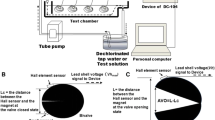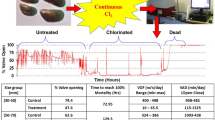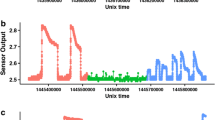Abstract
This study successfully applied an improved valvometry technique to measure waterborne copper (Cu), based on valve activity dynamics of the freshwater clam Corbicula fluminea. The improved valvometry technique allows the use of free-range bivalves and avoids causing stresses from experimental artifacts. The proposed daily valve rhythm models and a toxicodynamics-based Hill model were linked to predict valve dynamic responses under different Cu exposures with a circadian valve rhythm endpoint. Cu-specific detection threshold was 5.6 (95 % CI 2.1–9.3) and 19.5 (14.6–24.3) μg L−1 for C. fluminea, based on response times of 300 and 30 min, respectively. Upon exposure to Cu concentrations in excess of 50 μg L−1, the alteration of valve rhythm behavior was correlated with Cu concentration within 30 min, indicating notable sensing ability. This study outlines the feasibility of an in situ early warning dynamic biomonitoring system for detection of waterborne Cu based on circadian valve activities of C. fluminea.









Similar content being viewed by others
References
Basti L, Nagai K, Shimasaki Y, Oshima Y, Honjo T, Segawa S (2009) Effects of the toxic dinoflagellate Heterocapsa circularisquama on the valve movement behaviour of the Manila clam Ruditapes philippinarum. Aquaculture 291:41–47
Bonnard M, Romeo M, Amiard-Triquet C (2009) Effects of copper on the burrowing behavior of estuarine and coastal invertebrates, the Polychaete Nereis diversicolor and the bivalve Scrobicularia plana. Hum Ecol Risk Assess 15:11–26
Borcherding J (1994) The ‘Dreissena-Monitor’-improved evaluation of dynamic limits for the establishment of alarm thresholds during toxicity tests and for continuous water control. In: Hill IR, Heimbach F (eds) Freshwater field tests for hazard assessment of chemicals. Lewis, Boca Raton, pp 477–484
Borcherding J, Wolf J (2001) The influence of suspended particles on the acute toxicity of 2-chloro-4-nitro-aniline, cadmium, and pentachlorophenol on the valve movement response of the zebra mussel (Dreissena polymorpha). Arch Environ Contam Toxicol 40:497–504
Chambon C, Legeay A, Durrieu G, Gonzalez P, Ciret P, Massabuau JC (2007) Influence of the parasite worm Polydora sp. on the behavior of the oyster Crassostrea gigas: a study of the respiratory impact and associated oxidative stress. Mar Biol 152:329–338
Chen WY, Jou LJ, Chen SH, Liao CM (2012) A real-time biomonitoring system to detect arsenic toxicity by valve movement in freshwater clam Corbicula fluminea. Ecotoxicology 21:1177–1187
Devez A, Gomez E, Gilbin R, Elbaz-Poulichet F, Persin F, Andrieux P, Casellas C (2005) Assessment of copper bioavailability and toxicity in vineyard runoff waters by DPASV and algal bioassay. Sci Total Environ 348:82–92
El-Shenawy NS (2004) Heavy-metal and microbial depuration of the clam Ruditapes decussatus and its effect on bivalve behavior and physiology. Environ Toxicol 19:143–153
Garcia-March JR, Solsona MAS, Garcia-Carrascosa AM (2008) Shell gaping 104 behaviour of Pinna nobilis L., 1758; circadian and circalunar rhythms revealed by in situ monitoring. Mar Biol 153:689–698
Gnyubkin VF (2010) The circadian rhythms of valve movements in the mussel Mytilus galloprovincialis. Russ J Mar Biol 36(6):419–428
Higgins PJJ (1980) Effects of food availability on the valve movement and feeding behaviour of juvenile Crassostrea virginica (Gmelin). I. Valve movement and periodic activity. Exp Mar Biol Ecol 45:229–244
Jou LJ, Chen WY, Liao CM (2009) Online detection of waterborne bioavailable copper by vale daily rhythms in freshwater clam Corbicula fluminea. Environ Monit Assess 155:257–272
Jou LJ, Lin SC, Chen BC, Chen WY, Liao CM (2013) Synthesis and measurement of valve activities by an improved online clam-based behavioral monitoring system. Comput Electron Agric 90:106–118
Jou LJ, Liao CM (2006) A dynamic artificial clam (Corbicula fluminea) allows parsimony on-line measurement of waterborne metals. Environ Pollut 144:172–183
Kadar E, Salanki J, Jugdaohsingh R, Powell JJ, McCrohan CR, White KN (2001) Avoidance responses to aluminium in the freshwater bivalve Anodonta cygnea. Aquat Toxicol 55:137–148
Legeay A, Achard-Joris M, Baudrimont M, Massabuau JC, Bourdineaud JP (2005) Impact of cadmium contamination and oxygenation levels on biochemical responses in the Asiatic clam Corbicula fluminea. Aquat Toxicol 74:242–253
Liao CM, Jau SF, Lin CM, Jou LJ, Liu CW, Liao VHC, Chang FJ (2009) Valve movement response of the freshwater clam Corbicula fluminea following exposure to waterborne arsenic. Ecotoxicology 18:567–576
Liao CM, Jou LJ, Chen BC (2005) Risk-based approach to appraise valve closure in the clam Corbicula fluminea in response to waterborne metals. Environ Pollut 135:41–52
Liao CM, Jou LJ, Lin CM, Chiang KC, Yeh CH, Chou BYH (2007) Predicting acute copper toxicity to valve closure behavior in the freshwater clam Corbicula fluminea supports the biotic ligand model. Environ Toxicol 22:295–307
Nagai K, Honjo T, Go J, Yamashita H, Oh SJ (2006) Detecting the shellfish killer Heterocapsa circularisquama (Dinophyceae) by measuring bivalve valve activity with a Hall element sensor. Aquaculture 255:395–401
Ortmann C, Grieshaber MK (2003) Energy metabolism and valve closure behaviour in the Asian clam Corbicula fluminea. J Exp Biol 206:4167–4178
Santos HM, Diniz MS, Costa PM, Peres I, Costa MH, Alves S, Capelo JL (2007) Toxicological effects and bioaccumulation in the freshwater clam (Corbicula fluminea) following exposure to trivalent arsenic. Environ Toxicol 22:502–509
Sluyts H, Van Hoof F, Cornet A, Paulussen J (1996) A dynamic new alarm system for use in biological early warning systems. Environ Toxicol Chem 15:1317–1323
Sobrino-Figueroa A, Caceres-Martinez C (2009) Alterations of valve closing behavior in juvenile Catarina scallops (Argopecten ventricosus Sowerby, 1842) exposed to toxic metals. Ecotoxicology 18:983–987
Sow M, Durrieu G, Briollais L, Ciret P, Massabuau JC (2011) Water quality assessment by means of HFNI valvometry and high-frequency data modeling. Environ Monit Assess 182:155–170
Tran D, Ciret P, Ciutat A, Durrieu G, Massabuau JC (2003) Estimation of potential and limits of bivalve closure response to detect contaminants: application to cadmium. Environ Toxicol Chem 22:914–920
Tran D, Fournier E, Durrieu G, Massabuau JC (2004) Copper detection in the Asiatic clam Corbicula fluminea: optimum valve closure response. Aquat Toxicol 66:333–343
Tran D, Haberkorn H, Soudant P, Ciret P, Massabuau JC (2010) Behavioral responses of Crassostrea gigas exposed to the harmful algae Alexandriumminutum. Aquaculture 298:338–345
van der Schalie WH, Shedd TR, Knechtges PL, Widder MW (2001) Using higher organisms in biological early warning systems for real-time toxicity detection. Biosens Bioelectron 16:457–465
Williams BG, Pilditch CA (1997) The entrainment of persistent tidal rhythmicity in a filter-feeding bivalve using cycles of food availability. J Biol Rhythm 12:173–181
Acknowledgments
This work was supported by the Ministry of Science and Technology of the Republic of China under Grant MOST 100-2313-B197-005. The authors acknowledge two anonymous reviewers for making significant contributions to improve the quality of the final manuscript.
Author information
Authors and Affiliations
Corresponding author
Ethics declarations
Conflict of interest
The authors declare that they have no competing interests.
Additional information
Responsible editor: Henner Hollert
Electronic supplementary material
Below is the link to the electronic supplementary material.
ESM 1
(DOCX 7510 kb)
Rights and permissions
About this article
Cite this article
Jou, LJ., Chen, BC., Chen, WY. et al. Sensory determinants of valve rhythm dynamics provide in situ biodetection of copper in aquatic environments. Environ Sci Pollut Res 23, 5374–5389 (2016). https://doi.org/10.1007/s11356-015-5735-5
Received:
Accepted:
Published:
Issue Date:
DOI: https://doi.org/10.1007/s11356-015-5735-5




